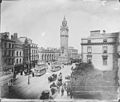This article needs additional citations for verification .(July 2014) |
| Belfast Corporation Tramways | |
|---|---|
 Royal Avenue, Belfast in the 1920s | |
| Operation | |
| Locale | Belfast |
| Open | 1 January 1905 |
| Close | 10 February 1954 |
| Status | Closed |
| Infrastructure | |
| Track gauge | 4 ft 9 in (1,448 mm) |
| Propulsion system | Electric |
| Statistics | |
| Route length | 51.45 miles (82.80 km) |
Belfast Corporation Tramways was an operator of tram, trolleybus and bus services in Belfast from 1905 to 1973. [1]






